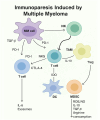Modeling the Bone Marrow Niche in Multiple Myeloma: From 2D Cultures to 3D Systems
- PMID: 40649999
- PMCID: PMC12249664
- DOI: 10.3390/ijms26136229
Modeling the Bone Marrow Niche in Multiple Myeloma: From 2D Cultures to 3D Systems
Abstract
Multiple myeloma is a hematologic malignancy characterized by the clonal proliferation of plasma cells within the bone marrow. The tumor microenvironment plays a crucial role in multiple myeloma pathogenesis, progression, and drug resistance. Traditional two-dimensional cell culture models have been instrumental in multiple myeloma research. However, they fail to recapitulate the complex in vivo bone marrow microenvironment, leading to limited predictive value for clinical outcomes. Three-dimensional cell culture models emerged as more physiologically relevant systems, offering enhanced insights into multiple myeloma biology. Scaffold-based systems (e.g., hydrogels, collagen, and Matrigel), scaffold-free spheroids, and bioprinted models have been developed to simulate the bone marrow microenvironment, incorporating key components like mesenchymal stromal cells, osteoblasts, endothelial cells, and immune cells. These models enable the functional assessment of cell adhesion-mediated drug resistance, cytokine signaling networks, and hypoxia-induced adaptations, which are often lost in 2D cultures. Moreover, 3D platforms demonstrated improved predictive value in preclinical drug screening, facilitating the evaluation of novel agents and combination therapies in a setting that better mimics the in vivo tumor context. Hence, 3D cultures represent a pivotal step toward bridging the gap between basic myeloma research and translational applications, supporting the development of more effective and patient-specific therapies.
Keywords: 3D culture models; bone marrow microenvironment; drug resistance; molecular mechanisms; multiple myeloma; organoids; spheroids; tumor–stroma interactions.
Conflict of interest statement
The authors declare no conflicts of interest.
Figures



Similar articles
-
Integrative analysis of bulk and single-cell gene expression profiles to identify bone marrow mesenchymal cell heterogeneity and prognostic significance in multiple myeloma.J Transl Med. 2025 Jun 16;23(1):659. doi: 10.1186/s12967-025-06637-6. J Transl Med. 2025. PMID: 40524208 Free PMC article.
-
Recent Advances in Three-Dimensional In Vitro Models for Studies of Liver Fibrosis.Tissue Eng Regen Med. 2025 Jul;22(5):593-609. doi: 10.1007/s13770-025-00719-8. Epub 2025 May 13. Tissue Eng Regen Med. 2025. PMID: 40358834 Review.
-
Engineered 3D ex vivo models to recapitulate the complex stromal and immune interactions within the tumor microenvironment.Biomaterials. 2024 Mar;305:122428. doi: 10.1016/j.biomaterials.2023.122428. Epub 2023 Dec 19. Biomaterials. 2024. PMID: 38147743 Free PMC article. Review.
-
Comparative analysis of 3D-culture techniques for multicellular colorectal tumour spheroids and development of a novel SW48 3D-model.Sci Rep. 2025 Jul 29;15(1):27687. doi: 10.1038/s41598-025-13588-x. Sci Rep. 2025. PMID: 40731083 Free PMC article.
-
Bone marrow stromal cells induce chromatin remodeling in multiple myeloma cells leading to transcriptional changes.Nat Commun. 2024 May 16;15(1):4139. doi: 10.1038/s41467-024-47793-5. Nat Commun. 2024. PMID: 38755155 Free PMC article.
References
-
- De La Puente P., Muz B., Gilson R.C., Azab F., Luderer M., King J., Achilefu S., Vij R., Azab A.K. 3D Tissue-Engineered Bone Marrow as a Novel Model to Study Pathophysiology and Drug Resistance in Multiple Myeloma. Biomaterials. 2015;73:70–84. doi: 10.1016/j.biomaterials.2015.09.017. - DOI - PMC - PubMed
Publication types
MeSH terms
LinkOut - more resources
Full Text Sources
Medical
Miscellaneous

